In-Depth with the Windows 8 Consumer Preview
by Andrew Cunningham, Ryan Smith, Kristian Vättö & Jarred Walton on March 9, 2012 10:30 AM EST- Posted in
- Microsoft
- Operating Systems
- Windows
- Windows 8
As soon as the setup process is finished, you’re presented with your first look at Windows 8’s primary innovation: Metro. This new UI, which originated in Windows Phone 7 and has since been extended to the Xbox 360, is the Wave of the Future at Microsoft, and it’s part and parcel of Windows 8. There is no classic Start menu to fall back on. There’s nothing built-in to the OS that allows you to disable it or boot to the desktop by default (though surely various hacks will enable this if they haven’t already). Metro is here, and if you use Windows 8 you’ll have to come to terms with it.
That’s because Microsoft is going a step further than Apple with regards to its operating systems: while Apple is busy porting iOS features and characteristics to a desktop operating system that is still recognizably OS X, Microsoft insists that the tablet is just another kind of PC, and to that end is building a unified OS for both tablets and traditional PCs. Microsoft tablets (whether running Windows 8 or Windows on ARM) will run the same core software as PCs, will be able to run many of the same apps as PCs, and (most importantly for Microsoft’s ecosystem of enterprise users) can be managed using the same tools as PCs. We’ve known for years that the traditional Windows desktop doesn’t work well on tablets, but does an interface designed for touch also work with a mouse and keyboard?
 Metro, with its large fonts, bold colors, and large buttons was designed to be touched, and I think once we get some tablets designed for Windows 8 people are going to warm up to it. It’s well thought-out and with a little polishing will stand up well to iOS and Android in terms of features, and in terms of aesthetics it's already there—animations are fluid and attractive, and nice touches like a volume overlay (see right—finally!) bring an extra level of modern polish to Windows.
Metro, with its large fonts, bold colors, and large buttons was designed to be touched, and I think once we get some tablets designed for Windows 8 people are going to warm up to it. It’s well thought-out and with a little polishing will stand up well to iOS and Android in terms of features, and in terms of aesthetics it's already there—animations are fluid and attractive, and nice touches like a volume overlay (see right—finally!) bring an extra level of modern polish to Windows.
Brian Klug and Ryan Smith talked a bit about using Metro on a tablet in their piece on September’s Windows 8 Developer Preview, a process which is more or less the same in the Consumer Preview, so what I’ll be focusing on here is the general layout and function of Metro in the Consumer Preview, and my experience using it with a keyboard and mouse.
Introducing Metro
We’ll start with the entry point: the new login/lock screen. In previous Windows versions, this screen told you nothing about the computer—it was simply a gateway, and as such it either showed you a list of user accounts on the computer or displayed a CTRL + ALT + DELETE prompt with username and password fields. In Windows 8, the lock screen shows you the date and time and your current battery life and network connectivity status, set against a user-configurable background. Other Metro apps, like Mail and Messages, can also be configured to display status and notification messages on the lock screen. The look is reminiscent of most tablets and smartphones, but its big, high-resolution, striking images reminded me more of the Kindle Fire than anything. It’s a nice effect.
Press any key on your keyboard and the login image will slide upward, revealing the traditional Windows name and password fields. Authenticate, and you’ll be looking at the Metro-style Start screen.
Tiles for Metro-style apps are big and colorful, and can usually be set to two sizes, a smaller square that allows for two tiles to sit side by side in a column, and a longer rectangle that spans the entire column. Metro columns on the Start screen will expand or contract to fill all of the screen resolution available to them, as evidenced in the screenshots above and below, and your mouse or trackpad’s vertical scrolling function will let you move left and right (horizontally, I know) through all of your apps. You can also scroll by grabbing the scrollbar at the bottom of the screen, or by moving your mouse pointer all the way to the left or the right of the screen.
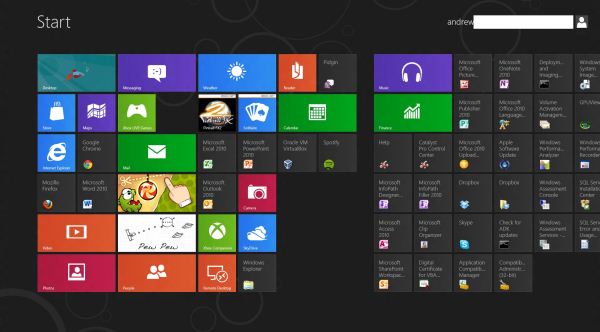
Displays with more pixels can display more items
Above, you can see most of what constitutes a Metro page: tiles of apps lined up into neat columns. Tiles can be moved around at will, and will try their best to rearrange themselves dynamically. The wider gap between two of the columns is a divider between “pages” of apps. There is no limit to the horizontal size of pages, and you can freely drag tiles to either side of these wider divides.
Right-clicking a Metro app will bring up a list of actions at the bottom of the screen—most Metro tiles will let you shorten or lengthen them, remove them from the Start screen, or uninstall them.
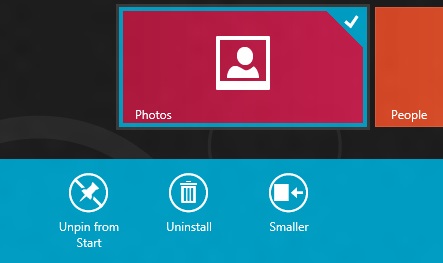
Standard desktop programs also show up on the Start screen as rather unglamorous-looking gray tiles that show the name of the program and its icon. Left clicking on it will dump you to the desktop and open the app as it would open in older versions of Windows, and right-clicking will bring up that app’s standard right-click menu in the Metro style across the bottom of the screen, with the added option to uninstall the program without going into the Programs and Features control panel.
To add and remove desktop app icons from the Start screen, right-click them and then click “pin to Start.” Desktop apps can be pinned to and unpinned from the desktop taskbar and the Start screen from the desktop or from Metro, the first of many ways in which the two interfaces are integrated.
Windows Search can be invoked automatically from the Start screen if you begin typing. In Windows 8, there are three distinct search categories: Apps, which will display most Metro and desktop programs; Settings, which will search through the Metro and desktop control panels; and Files, which is self-explanatory. You can also search through any Windows Search-enabled Metro app, which you can see listed below the three main headings. I’d love to see a unified search group like we had in the Windows 7 Start menu, especially given the sometimes-blurry line between what appears in Settings and what appears in Apps, but search in Windows 8 is powerful and it’s fast, even using slower processors and mechanical HDDs.
All Metro apps, including the desktop, can be “snapped” to the left or right edge of the screen, which lets one app use up about a fifth of the screen while another app uses the remaining space—I’ve seen this called “Metro Snap” and that’s how I’ll refer to it for the rest of the article. This is especially useful for things like Twitter or messaging clients that work well with a single vertical strip of screen space. Metro Snap will only work on panels that are 1366x768 or higher—anything smaller has too few horizontal pixels to make effective use of the feature—but the Windows desktop’s Aero Snap features will continue to work as they did in Windows 7.
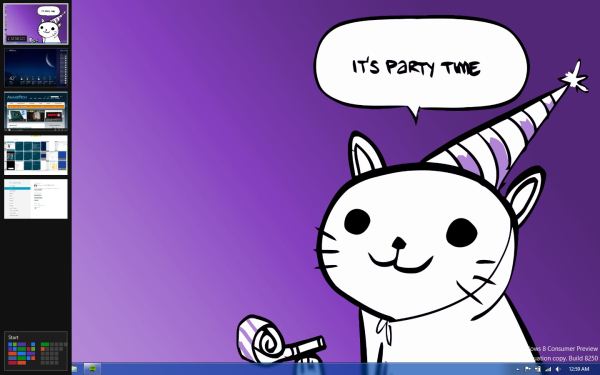
Party Cat knows when it is time to party. Also, the app drawer is on the left.
Metro has a few menus that can always be brought up no matter what app you’re using: the left edge of the screen is for an application drawer (above), which serves a function similar to the application switchers in iOS and Android. It shows all of your currently running apps and allows you to either switch to them from the currently running app or close them. The desktop will show up in the application drawer as a single item regardless of how many programs you have running on it, and while you can “close” it, this only makes the tile vanish from the drawer, and won’t close any of the programs running on the desktop.
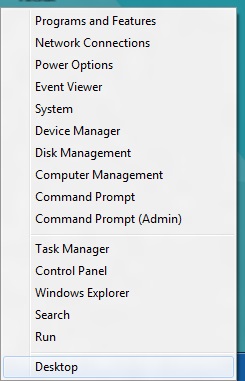
Update: Several readers have pointed out that right-clicking in the lower left corner of the screen brings up a mini-Start menu of sorts, where the Explorer, Search, the Run dialog box and several control panels can be accessed more easily. Thanks to all who sent this in!
The right edge of the screen is for Charms (above), Microsoft’s name for the buttons that let you access several high-level settings and features. The Charms are, from top to bottom:
- Search, which brings up the Search menu (which, remember, can also be invoked by typing from the Start screen). The default search view is Apps.
- Share. While in a Metro app like Photos, you could use this charm to send a picture to someone using another Metro app like Mail.
- Start, which brings up the Start screen.
- Devices, which brings up attached devices like printers and extra monitors and gives you some configuration options for them—for instance, it will allow you to change your display settings if you’ve got a second monitor or projector attached, and it will bring up a Print menu if you click an attached printer. This charm is context-sensitive—if there’s nothing in your app to print (or if the app doesn’t support it), for example, any printers attached to your computer won’t show up in the menu as a selectable option.
- Settings. This brings up both general settings and options for the currently-running application as well as some system-wide settings like brightness, volume, notifications, language, network connectivity, and shutdown options. The “More PC Settings” link brings up the system-wide Metro control panel, where one can control things like the lock screen and Metro backgrounds, your PC’s refresh and reset functionality, and a few other settings.
Screen resolution requirements
As we’ve discussed, using Metro Snap requires a screen resolution of at least 1366x768, but there’s one more very important resolution requirement in Windows 8.
While working on my netbook, I quickly found that almost all Metro apps included in the Consumer Preview wouldn’t run on its 1024x600 display. After some research I found that, yes, Metro apps are only going to run on screens that are 1024x768 or higher. It’s important to give developers a minimum screen resolution to shoot for (and we may even see some tablets that use 1024x768 panels, given the precedent set by the iPad, the HP TouchPad, and others), but it means that users of PCs with smaller screens aren’t going to be able to use Windows 8’s defining feature (though the Start screen and system menus will still work just fine). This is too bad, since the limited amount of screen space on a netbook is a decent fit for Metro's simplified interface and full-screen apps.
Now that you know the basic features and layout of Metro, it’s time to teach you how to use it with a mouse and keyboard.


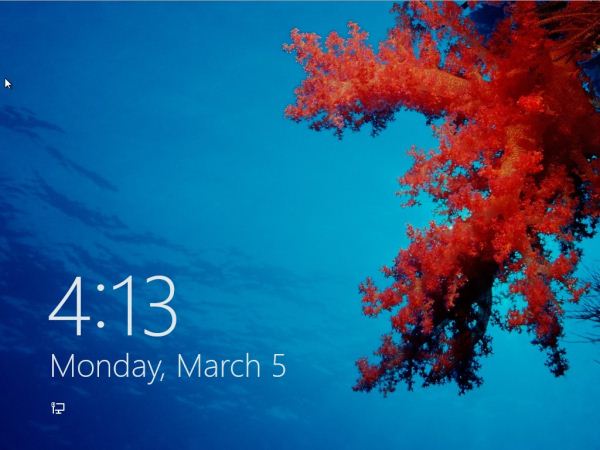
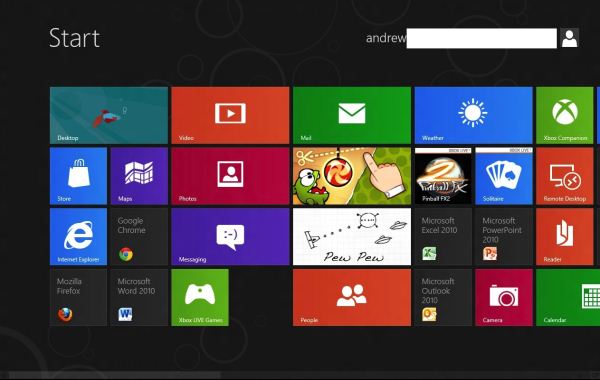
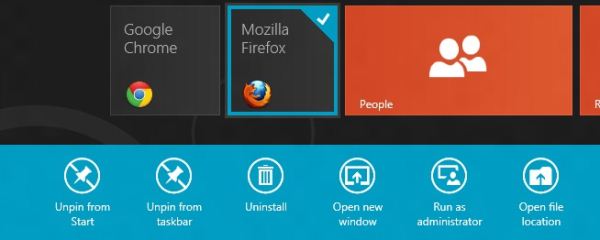
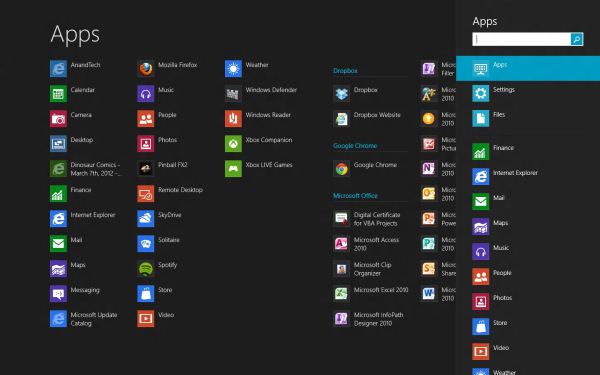
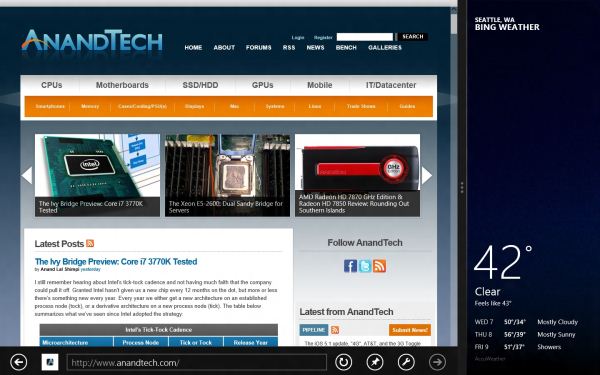
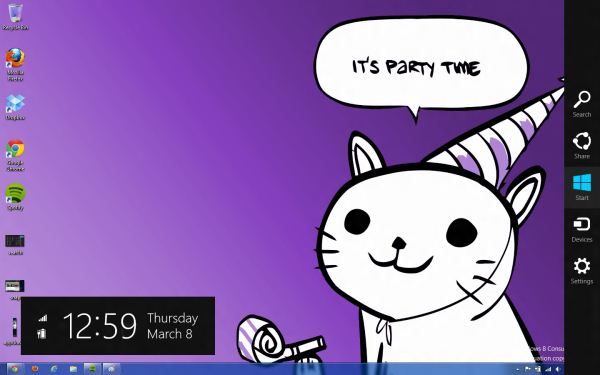








286 Comments
View All Comments
PopinFRESH007 - Sunday, April 15, 2012 - link
So you are saying Microsoft should have made OSX Lion, but without all the smooth animation nice looking graphics.#1 Full Screen Apps, and they do work great. Also mission control is very fast to switch between programs. When you make a program full screen, it creates it own virtual desktop space so you can fluidly move from your windowed programs and those you like to focus on with the full screen.
#2 I don't know why you would want to force users to change what they like about customizing their desktop just to push a separate disjointed UI.
And the rest of what you said, Apple has managed to do exactly what you described. You can test your programs extensively in Xcode (just like you can in Visual Studio) before submitting them to the AppStore. Apple also thought of the internal software developed by companies and they have an enterprise program that allows you to distribute your private software internally for iOS devices. This isn't needed with OSX yet because it's not a completely walled garden. Watch the video, and compare what you were describing to the information on the OSX Lion page.
http://www.apple.com/macosx/whats-new/#video-lion
Wardrop - Saturday, March 10, 2012 - link
On the page with the "Working with a mouse" section, you probably mention the inefficiencies of the "action bar" that appears at the bottom of the screen when you right-click some things, which replaces a traditional context menu. The biggest problem is that you need to move your mouse a lot further than you otherwise would need to with a context menu. If this remains, I know for sure that this will annoy the crap out of me, especially on a larger screen - it's just one of many examples where a touch-optimised interface has come at a sacrifice to pointer-based devices.Touch optimisation should be complementary to a traditional pointer-optimised interface. I don't understand why microsoft have been so careless with their implementation of a unified touch/pointer interface.
beginner99 - Saturday, March 10, 2012 - link
...is that at least for home use I think it could live and at work we are still using xp and will be upgraded to win 7 sometime this year. Its a safe guess win 7 will be around at least as long as XP.akse - Saturday, March 10, 2012 - link
"Start screen serves as a much more configurable and useful application launcher than the tiny Start menu ever was."I disagree. I don't need a fullscreen splash search feature for the software parser to parse through the stuff I type to the search field.
I probably wouldn't need that start menu either, just a field to type in by pressing win-button and then some list of stuff it finds.
Start menu as an application shortcut as of now in win7 is pretty ok too. It's not too messy and you can easily hide some extra stuff you don't use much under some folders (tools, software etc.). Sometimes i just browse it with mouse if I don't remember what I had installed.
Also you can pin your favourites there or quick bar.
B3an - Saturday, March 10, 2012 - link
You can pin anything the Win 8's Start screen.And searching is far better, you can see way more results. On my 30" monitors i get up to 150 results, with large easy to recognise icons. Compare that to a handful in the tiny cluttered Start menu.
You're just another dinosaur who cant deal with change.
Zaranthos - Saturday, March 10, 2012 - link
If Microsoft has the same attitude as you, insulting their long time customers who don't like change they don't even need, then they'll lose those customers and their money.I could make a full page list of improvements that could be made to Windows 7 and almost none of them will be in Windows 8 or probably Windows 9 for that matter. Trying to shove a new UI down peoples throats won't work out well for Microsoft.
JohnUSA - Saturday, March 10, 2012 - link
I am not a pessimist, but I hate Windows 8 with mouse and keyboard experience.I really believe that Microsoft should have released 2 versions, one for tablet/touch screen users and the second for current desktop/laptop users. The desktop experience is not acceptable to me, so I will never buy Windows 8. Microsoft should go back to the drawing board and re-write Windows 8 just for mouse and keyboard use for users like me, which we are in the millions and the majority of users. I do not want Metro as it makes my life hell.
My demand is simple, I want a good and efficient OS experience, and so far Windows 8 is not providing it.
My prediction is that stupid and stubborn Microsoft is going to be a big loser as many users like me will not touch this abysmal and irritating OS.
dduncan - Saturday, March 10, 2012 - link
in reply to hardware the acer w500 runs the 32bit W8 very good. Message: I am writing this hoping it will find its way to someone that will listen. I use my 7 year old granddaughter as my main ginipig for this experiment but I also took windows to work on a tablet and a small pc for people to try and I tested my wife and neighbor. Here are my results. For myself I use an Iphone (work supplied) a gaming pc at home along with a ThinkPad and a MacBook pro also I have a ipad 2, an Acer a500 and w500 (with windows 8). My experience is windows needs much better track pad support that's the only place a mac beets the window laptop machines. This on a laptop is 80% of my input. Windows 8 tablet is great much better than an ipad and android just sucks. On windows 8 I implore you to do three things. Easily let people chose what desktop to log into. Put the start button back. Make a new start button next to it to get into metro start menu. My reasons are as follows. First my neighbor he is retired, wealthy and smart. Loves the tablet and will buy one. He will not switch to a metro desktop. Can't figure out the business move behind you decision. This is coming from a successful railroad man. My wife uses the windows phone 7 so the windows 8 tablet was very natural for her she liked it very much but prefers her ipad because of weight which I'm sure will change buy the release date and she will probably switch to windows 8 tablet with the right hardware. On the desktop she will not use the metro u.i. even though she knows it. She is a secretary and very fast on a pc but the metro u.i. slows her down to do work. At work everyone loved the tablet with windows 8 so much so that our office manager which is a tech junkie like me ordered the Acer w500 and will have me put windows 8 on it next week. However everyone said no to a windows pc with metro u.i. and no start button. I can't emphasize enough no start button is a deal breaker. Our office always upgrades to the newest operating system. The ribbon in office was enough for them to all learn and there not about to learn a new interface. The big experiment my granddaughter. I let her use whatever she wants and never influence her on her choice. This can be nerve racking when a 7 year old is walking around without a care in the world and a five hundred tablet. She uses any phone android (her mom's) windows 7 (her grandmas) and my Iphone. She is proficient on all and shows us some tricks. It seems a phone is very much a tool for her so she doesn't care what type it is. On laptops she only likes the ThinkPad. I don't know why but she doesn't like to use a cheap Toshiba laptop I got her and she doesn't like the MacBook. On the tablet is what's most interesting. She loves the Ipad, hates android, and jumped right on the windows 8 tablet. In the few days she's got to use it. It seems as though it's her favorite by far. However on the desktop she won't use the metro u.i. and asked why they (you) would take away the way she gets to her stuff. In closing it is my beliefs that if you let internal politics and not consumers decide what the customer wants you will have windows 7 for ten + years like xp and a great tablet os. Very few upgrades and if people have to learn an operating system from scratch mac sales will go up and pc sales down. Very few offices will upgrade. Please just do three things to get a truly NO COMPROMISE (your new slogan) experience. LET PEOPLE CHOSE WHICH DESKTOP TO START ON. PUT THE START BUTTON BACK. MAKE ANOTHER START BUTTON NEXT TO IT TO GO TO THE METRO U.I.SINCERELY: David Duncan
Jyrkz - Saturday, March 10, 2012 - link
first of all id like to point out that I'm a AMD-ATI fan boy, but im not one of does AMD boys that have anger management issues:D i do realize that intel is pwning amd in CPU VS CPU. Sad but true.But AMD has its own GPU(+APU if you know what i mean ), thats where intel will be blown away.
This year ARM will arrive as well. I really hope AMD will beat ARM cause it would really suck if AMD was 3rd in CPU ;).
Anyway, the review was nice! keep up the good work and you all be seeing me around here :D
Pantsu - Saturday, March 10, 2012 - link
"For multi-monitor users, Microsoft provides some extra-wide wallpapers that can stretch across multiple screens, but there’s still no way to use a different wallpaper for each desktop, something that OS X has supported forever."Actually I think it can, at least my W8 desktop has 3 different wallpapers on my monitors.
http://i.hardware.fi/storage/pictures/1024/eyefini...